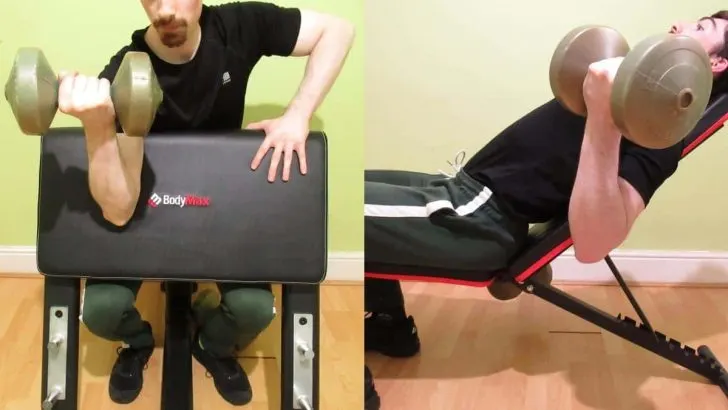Training the muscles of the biceps with dumbbells can build slabs of mass if you perform the right exercises and use the correct technique. So, in addition to 3 dumbbell bicep workouts, we created a list of the most effective free weight biceps exercises for building muscle.
Related: Best dumbbell tricep exercises
12 best dumbbell bicep exercises
You can use our list of the best dumbbell bicep exercises to learn the correct form and create your own custom workouts. To keep things simple, we made this exercise list dumbbell-only. But we also have a barbell biceps workout guide if you want more options.
Since these exercises are dumbbell-only, you can easily integrate these movements into an existing program or perform them separately if you’re doing your biceps workout at home with dumbbells.
1. Dumbbell curls
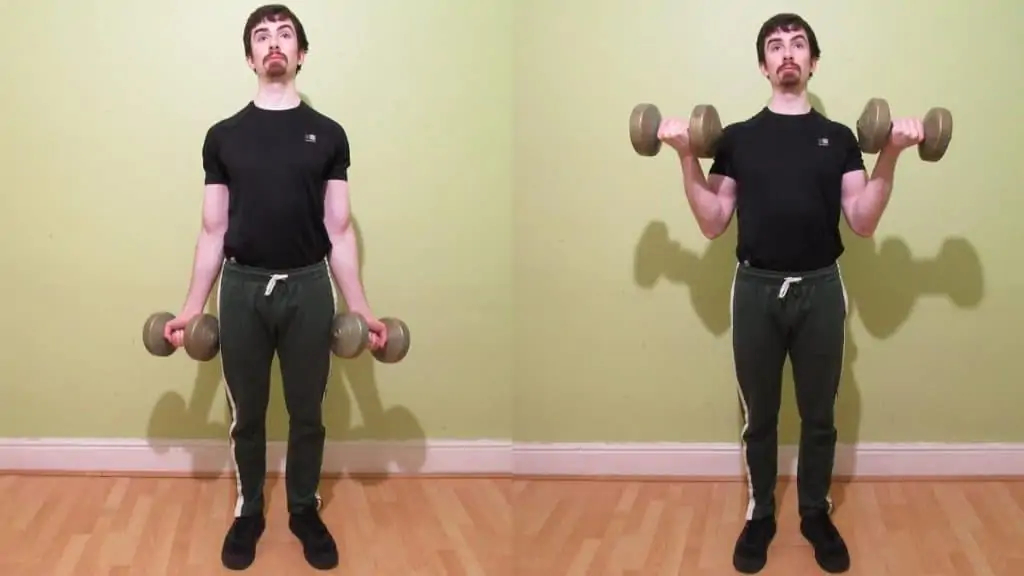
Standing bicep curls are one of the best bicep dumbbell exercises for mass gain that you can do. This is because by curling with a fully supinated grip, you’re putting the maximum amount of tension on the biceps since forearm supination (turning your palms up) is one of the primary functions of the biceps brachii.
Just make sure to really twist your wrists at the top of each rep. This way, you’ll generate the strongest possible bicep contraction and ensure that you’re recruiting the most amount of muscle fibers on every rep that you perform.
- Hold a pair of weights by your sides.
- Curl the dumbbells toward your shoulders by flexing your biceps.
- Keep curling until your forearms press right up against your biceps.
- Hold the peak contraction for a moment.
- Slowly lower the weights back down to your sides.
- Repeat for 3-5 sets of 6-12 reps.
2. Hammer curls
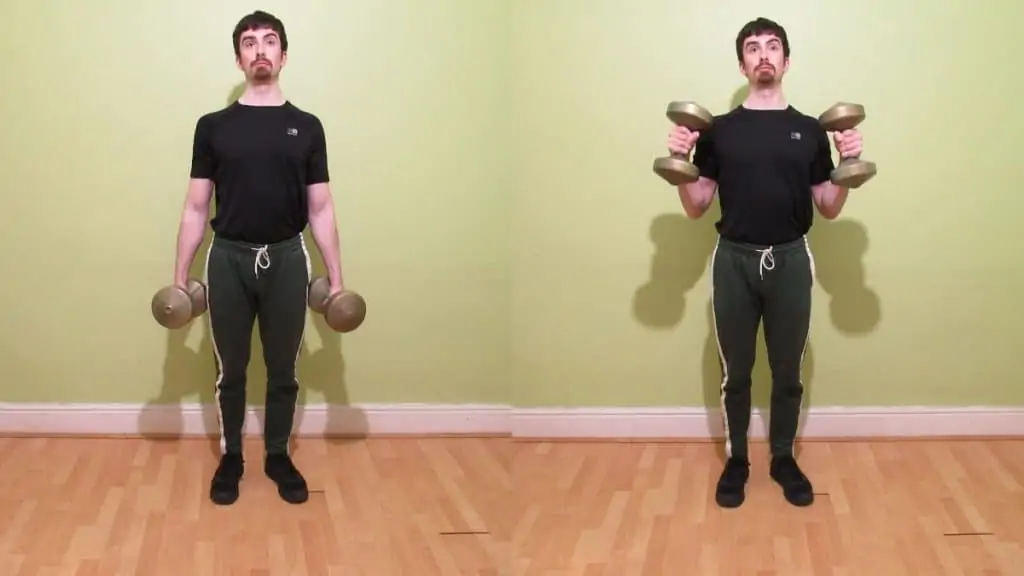
Hammer dumbbell curls are one of the most popular free weight bicep exercises because they also “hammer” your brachialis and brachioradialis muscles in addition to your biceps. This is because by curling with a neutral grip, you’re putting the brachialis and brachioradialis in a stronger force-producing position than when you curl with a supinated grip. Hence why you can lift heavier on hammer curls than on regular curls.
Since hammer curls are so conducive to lifting heavy and thus ideal for low rep training, your best bet is to perform them at the beginning of your dumbbell bicep workout when you’re naturally at your strongest. This way, you can lift the heaviest possible weights to train the all-important fast-twitch muscle fibers (they have a higher growth potential than the slow-twitch fibers).
- Hold a pair of dumbbells by your sides with a neutral grip.
- Curl the weights toward your shoulders until your forearms and biceps make firm contact.
- Squeeze your biceps and the top of your forearms for a moment.
- Lower the weights under control until they’re back by your sides.
- Perform 3-5 sets of 6-12 reps.
3. Concentration curls
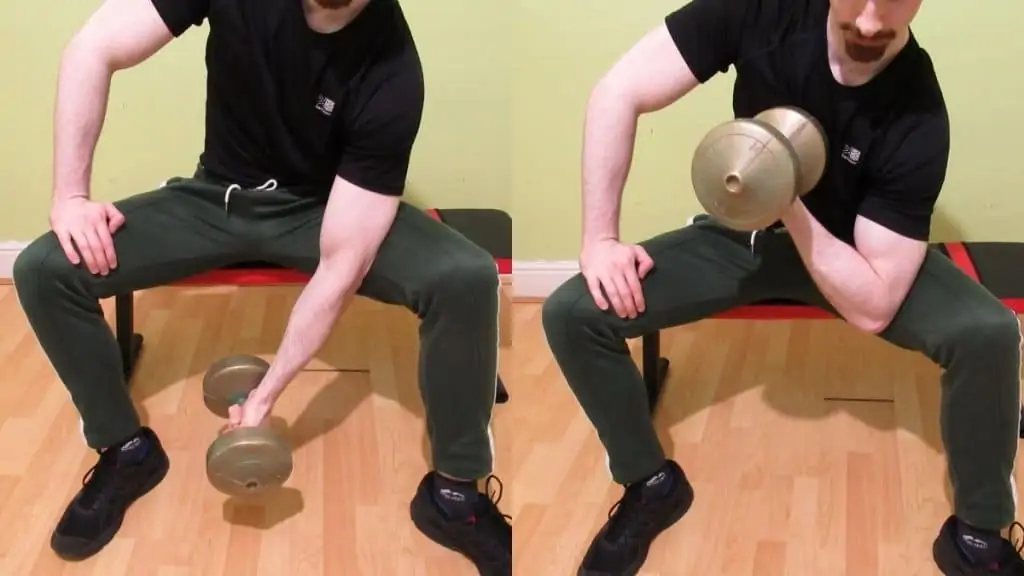
One arm concentration curls make an excellent addition to any bicep dumbbell workout because they enable you to train your arms unilaterally, which is to say separately. Therefore, concentration curls greatly reduce your chance of developing muscular imbalances because you can ensure that each bicep receives roughly equal work and thus grows more or less in proportion to its opposite.
While you can perform concentration curls standing, you’re best off doing them seated so that you can put forth a stronger mind-muscle connection (when you’re standing up, you have to focus on maintaining a tight core as well).
- Hold a dumbbell with a supinated grip.
- Sit on the edge of a weight bench.
- Rest your elbow against the inside of your leg.
- Let your elbow fully extend so that the dumbbell is close to the floor.
- Begin the rep by curling the weight toward your shoulder.
- Squeeze your bicep as it presses up against your forearm.
- Lower the dumbbell under control until your elbow is once again locked out.
- Repeat with your other arm and do 3-5 sets of 10-15 reps per side.
4. Incline curls
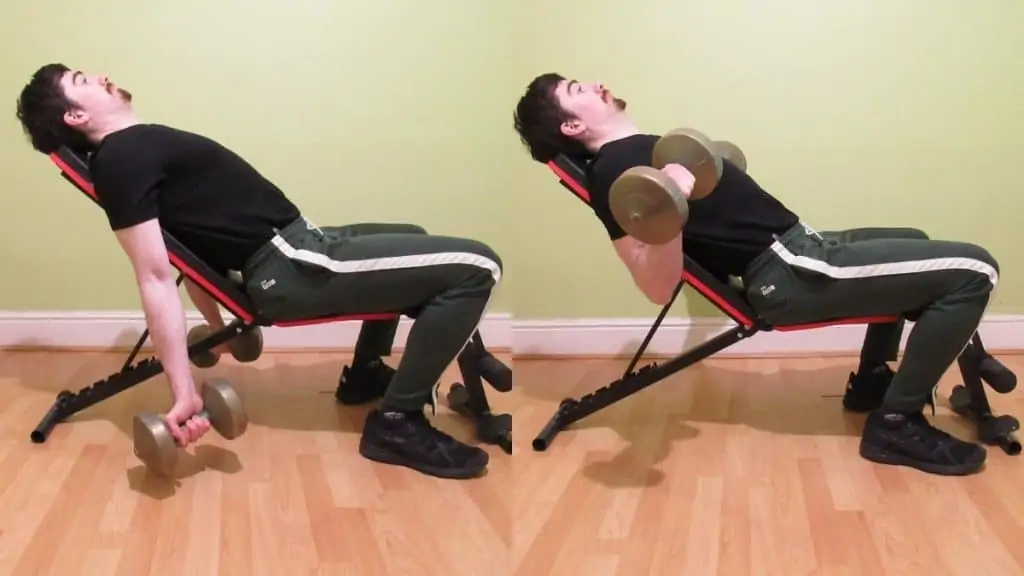
If you want to do a killer bicep workout with dumbbells to get those gains, then make sure to include the incline bench curl in your routine. This muscle-building movement places a greater stretch on your biceps than any other exercise in this list, so it’s very effective for gaining mass.
The trick is to keep your elbows still while you perform the movement. This way, the weights will remain slightly behind your body, and thus the emphasis of the exercise will remain on the long (outer) head of your biceps.
- Position the backrest of an adjustable bench to between 45 and 60 degrees.
- Grab a pair of dumbbells and then sit on the incline bench.
- Rotate your hands into a supinated (palms-up) position and let the weights hang over either side of the bench.
- Curl the dumbbells toward your shoulders while keeping your elbows still.
- Keep lifting the weights until your biceps and forearms make forceful contact.
- Hold the peak contraction for a second.
- Lower the weights under control until your elbows reach full extension.
- Repeat for 3-5 sets of 8-12 reps.
5. Zottman curls
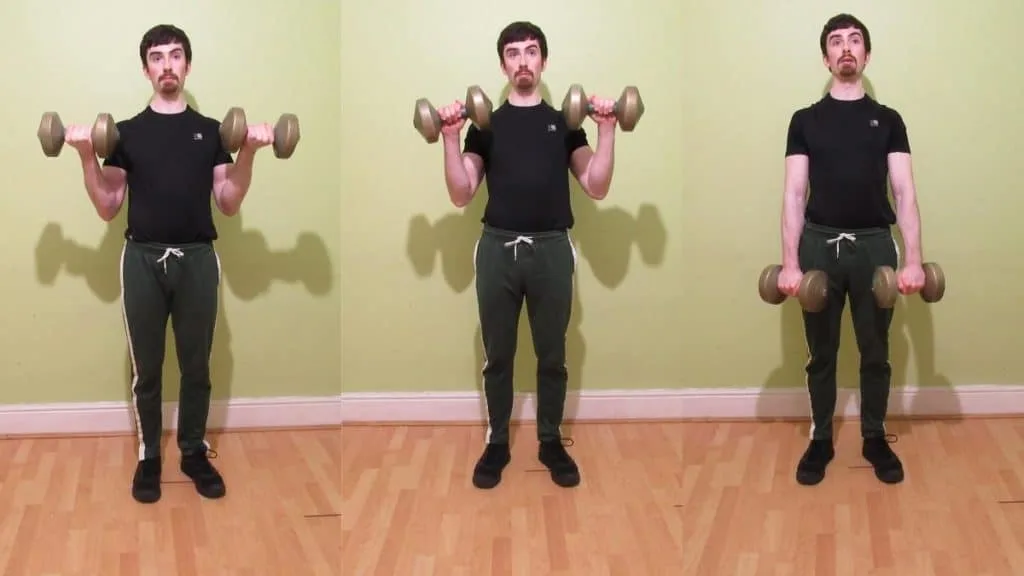
Zottman curls are one of the best bicep free weight exercises that you can perform because they build the brachialis and brachioradialis muscles as well as the biceps. To put it another way, you’re using the strength of your biceps during the concentric phase of the rep to overload your brachialis and brachioradialis—with more weight than they could otherwise handle by themselves—during the eccentric portion of the rep.
But there are other Zottman curl benefits as well. Zottman curls are a very time-efficient exercise because they train three muscles in the same amount of time that it would usually take you to work one muscle. So if you want your dumbbell bicep workout routine to be short and intense, then Zottman curls are one of the best exercises to do.
- Hold a pair of dumbbells by your sides with a thumbless underhand grip.
- Curl the weights toward your front delts until your biceps make firm contact with your forearms.
- Rotate your hands into a pronated (palms-down) position.
- Slowly lower the dumbbells back to your sides with this overhand grip.
- Once your elbows reach full extension, turn your wrists back to their original supinated position in preparation for the next rep.
- Perform 3-5 sets of 8-15 reps in total.
6. Dumbbell preacher curls

Single arm preacher curls are one of the best dumbbell exercises for biceps mass that you can do because they’re a unilateral exercise. This means that you only need to focus on training one bicep at a time; hence, you can put more effort into each set and lift heavier weights.
As mentioned, training each bicep separately also minimizes your chance of developing muscular imbalances because you can make sure that each arm is receiving roughly equal amounts of stimulation. So ultimately, performing single-arm exercises will help you to sculpt a more symmetrical physique.
- Grab a dumbbell and then sit on the preacher curl station.
- Turn your palm up so that you’re holding the weight with an underhand grip.
- Brace the arm that’s holding the dumbbell against the preacher pad.
- Hold the top of the pad with your spare arm for support.
- With your elbow fully extended, curl the weight toward your shoulder.
- Squeeze your bicep forcefully at the top of the rep (as it presses up against your forearm).
- Lower the dumbbell under control until your arm is fully locked out.
- Repeat for 3-5 sets of 10-15 reps.
7. Spider curls
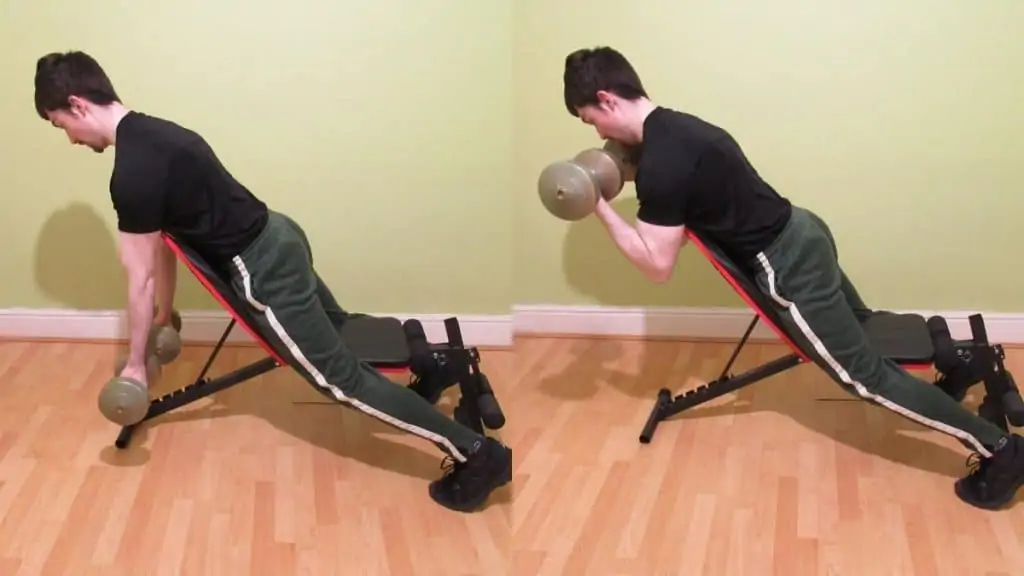
Spider bicep curls produce an extremely intense peak contraction because they train the biceps at a shortened muscle length, which is to say, when your shoulders are in flexion (i.e., in front of your body). As a result, including spider curls in your bicep dumbbell workouts is an excellent idea because they also give you an unbelievable muscle pump (short muscle lengths = great pump, lengthened muscle = great stretch).
The only downside is that the setup and positioning can feel a little awkward. For example, if you have short arms, then you might not be able to reach down to grab the dumbbells. Similarly, pressing your chest into the backrest of the bench can often feel uncomfortable and put pressure on your sternum.
- Set the backrest of an adjustable bench to a 60-degree angle.
- Grab a pair of dumbbells with an underhand grip.
- Sit on the bench in a reverse position with your chest pressed against the back pad.
- Let your arms hang forward so that your elbows are fully extended.
- Curl the weights toward your front delts until your forearms press up against your biceps.
- Hold the peak contraction for a moment and then lower the dumbbells under control until your arms are once again locked out.
- Repeat for 3-5 sets of 10-15 reps.
8. Seated dumbbell curls
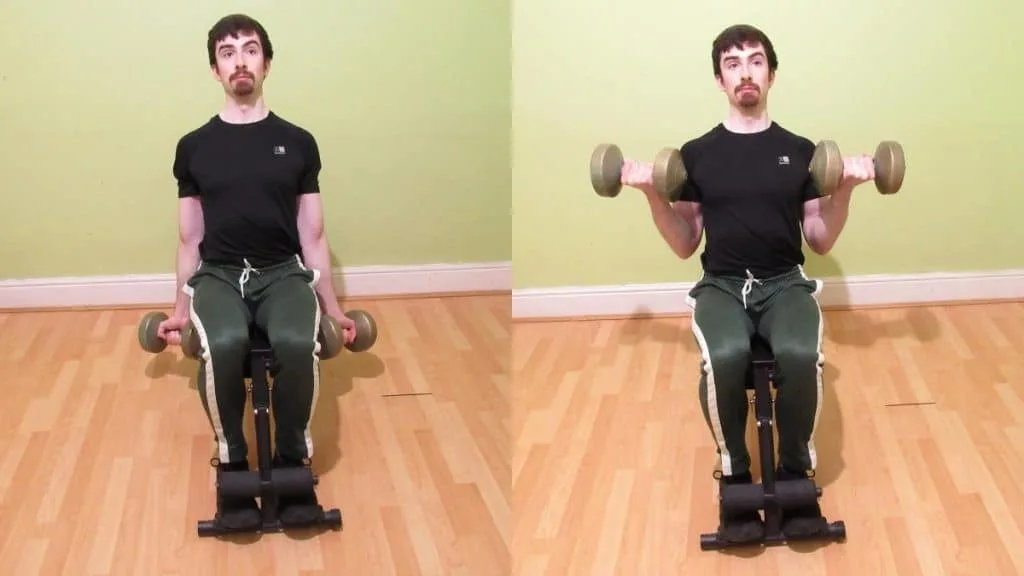
When you’re doing biceps exercises with dumbbells, you can oftentimes lift heavier weights by performing them in a seated position. This is because curling while sitting down requires less core stability since you can brace your back against the weight bench.
So by doing seated dumbbell curls rather than the standing variation, you can channel all of your efforts into blasting your biceps because you don’t need to waste strength on maintaining an overly rigid core.
- Set the backrest of a weight bench to a 90-degree angle (or somewhere close to it).
- Hold a pair of dumbbells with an underhand grip.
- Sit on the bench with your arms pinned into your sides.
- Curl the weights toward your front delts while keeping your elbows still.
- Squeeze your biceps forcefully at the top of the rep as they press up against your forearms.
- Slowly lower the weights back down to your sides.
- Repeat for 3-5 sets of 8-12 reps.
9. Seated hammer curls
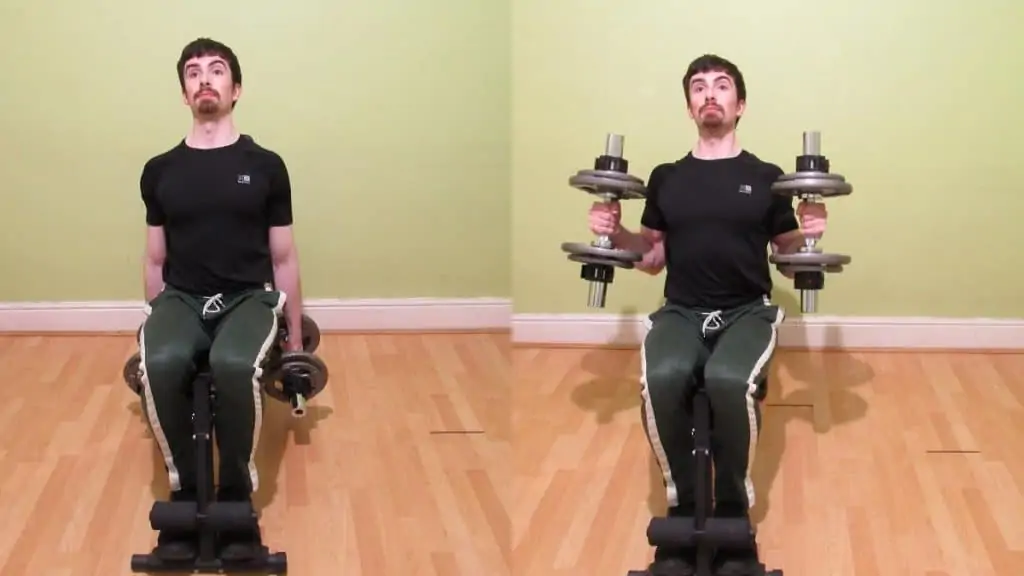
Whenever you do bicep workouts with weights, it makes sense to perform some kind of hammer curl so that you can build proportional arms and not just gargantuan biceps. This is because hammer curls also work the brachialis and brachioradialis muscles, which, when well-developed, will make your arms look bigger and broader.
Although you need a bench to do seated hammer curls properly (the standing version only requires weights), doing them seated may very well make you stronger because, as mentioned, the core stability requirement of the exercise is lower when you can lean against the back pad of the bench.
- Set the back pad of an incline bench to 90-degrees.
- Hold a pair of weights with a neutral grip and sit on the bench.
- Curl the dumbbells toward your shoulders while keeping your elbows stationary.
- Keep curling the weights until your forearms press right up against your biceps.
- Hold the contraction for a second and then lower the weights under control until your elbows reach full extension.
- Repeat for 3-5 sets of 8-12 reps.
10. Alternating dumbbell curls
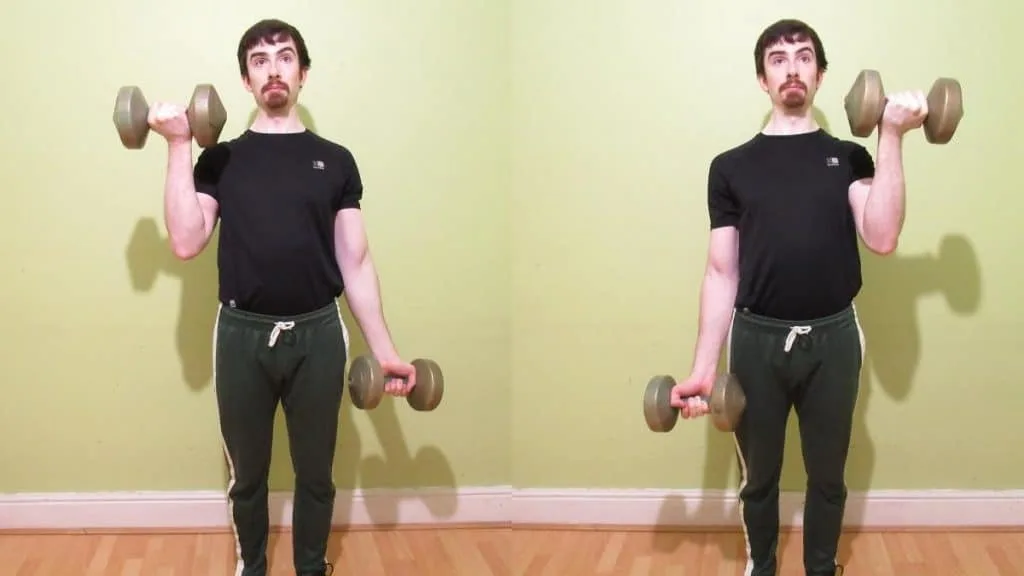
If you’re doing dumbbell workouts for biceps size rather than just to get toned, then definitely consider including the alt dumbbell curl in your routine.
Like performing your curls seated, you can often lift heavier weights when you curl in an alternating fashion. This is because your brain only has to focus on lifting one limb at a time, and so you can naturally produce more force when your focus isn’t spread over multiple areas (strength has a sizable neurological component to it).
- Hold a pair of dumbbells by your sides with an underhand grip.
- Curl one of the weights toward your shoulder while keeping your other arm completely still.
- Keep curling until your bicep and forearm make forceful contact.
- Hold the contraction for a second and then lower the weight back down to your side.
- Do the same with your other arm and perform 3-5 sets of 6-12 reps per side.
11. Cross body hammer curls
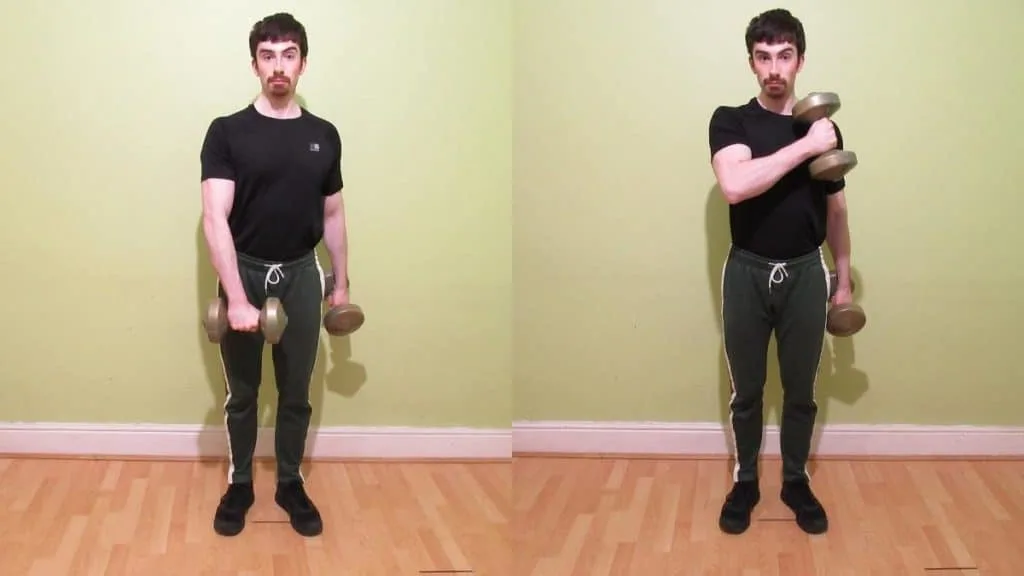
If you want to build the long (outer) head of your bis as well as your brachioradialis, then it’s a great idea to include the cross body hammer curl in your biceps dumbbell workout routine. By lifting one weight at a time, you’ll see an immediate—if only slight—increase in strength because your brain won’t have to split its focus across two limbs; your working arm gets the full attention of your central nervous system.
Similarly, by curling across your body rather than in front of it, you’ll naturally shift more of the tension on the outer muscle fibers of your biceps. This is an area that many lifters neglect and which can also enhance the peak of your biceps given enough time.
You can also do incline hammer curls to put your biceps and co under a greater stretch. This will, however, mean lifting slightly lighter weights because the biceps are naturally in a weaker position when they’re at longer muscle lengths (i.e., when they’re stretched.)
- Hold two weights by your sides with a neutral grip.
- Curl one dumbbell across your body toward the opposite shoulder while keeping your other arm still.
- Keep curling the weight until your forearms and biceps make firm contact.
- Squeeze your biceps forcefully and then lower the weight back to your sides.
- Repeat the movement with your other arm and do 3-5 sets of 8-12 reps in total.
12. Reverse dumbbell curl
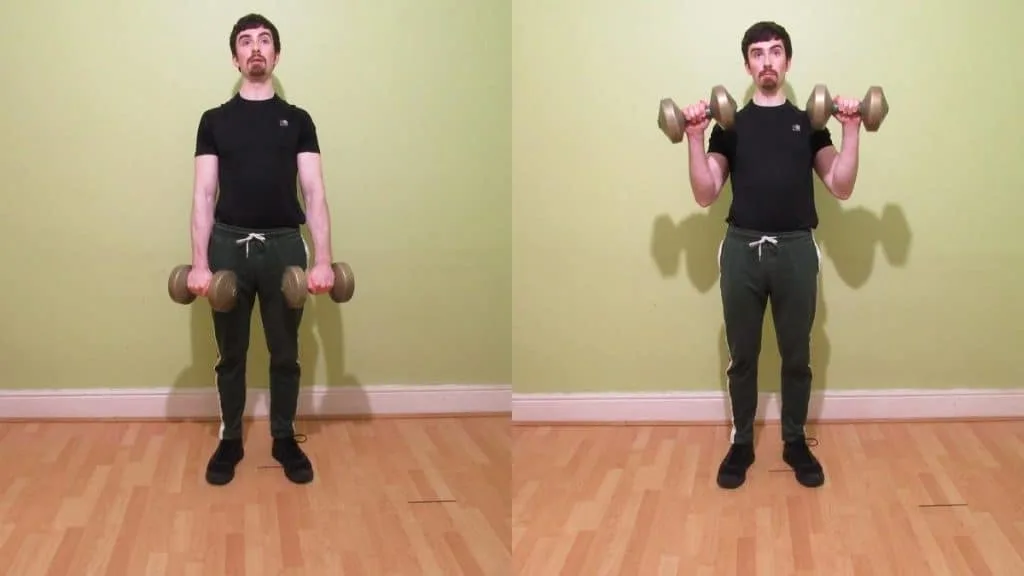
Whenever you do bicep workouts with dumbbells, or with any other equipment, for that matter, it makes sense to include some kind of reverse curl so that you can train your brachialis and brachioradialis muscles optimally.
Doing a reverse dumbbell curl places your biceps in a position of mechanical disadvantage in which they can’t produce much force. This means that your brachialis and brachioradialis have to pick up the slack and do most of the lifting, which means that they also get to enjoy most of the tension as well. So if you want muscular arms from every angle (not just bulging biceps), then make sure to do reverse curls or at least hammer curls during your dumbbell bicep routine.
- Hold a pair of dumbbells by your sides with an overhand grip.
- Pin your arms into your sides and then curl the weights toward your shoulders.
- Lift the dumbbells until the tops of your forearms press right up against your biceps.
- Hold the peak contraction for a second.
- Lower the weights back down under control until your arms are locked out.
- Repeat for 3-5 sets of 10-15 reps.
Best bicep workouts with dumbbells
We created a dumbbell biceps workout for each ability level—novice, intermediate, advanced—so that you can make gains at the optimal rate without overtraining or doing too little volume. [1]
Note, however, that ability level or level of advancement is determined on a per muscle basis. So if you have relatively weak legs but good biceps, then you can skip the starter workout and move straight onto the intermediate routine.
For a different kind of stimulus (i.e., constant tension), see our cable biceps workout guide. Keep reading for free weight routines.
Workout 1: Starter
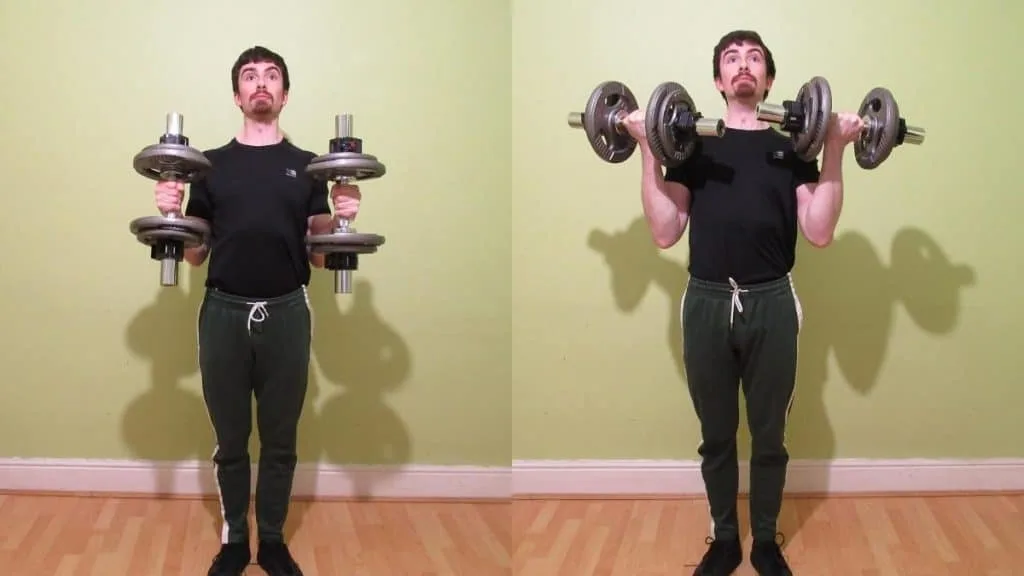
1: Hammer curls — 3-5 sets of 6-10 reps
2: Dumbbell curls — 3-5 sets of 8-12 reps
3: Concentration curls — 3-5 sets of 10-15 reps
This routine is the best dumbbell bicep workout for novice lifters to make gains. It has plenty of training volume (between 9 and 15 sets!) for you to build muscle, but not so much that you risk overtraining or hampering your recovery.
Hammer curls focus on building overall arm mass, and so you should lift as heavy as possible (but do leave one rep in the tank on each set so that your biceps don’t fatigue prematurely).
Dumbbell curls hone in on the biceps while keeping things simple—all you need is a pair of weights. Of course, there are more elaborate dumbbell biceps exercises out there that you can do to work your muscles from different angles. However, it’s recommended to stick to the basics when you’re a novice lifter so that you can make solid strength progress and gain tangible muscle size.
In other words, if you keep switching exercises, you often have to reset the weight and start over again. So stick with regular curls until you have a good foundation of mass.
We also included concentration curls in this dumbbells biceps workout so that you can train each arm separately and limit the development of muscular imbalances.
Aim to rest 2-3 minutes between each set. [2]
Workout 2: Intermediate
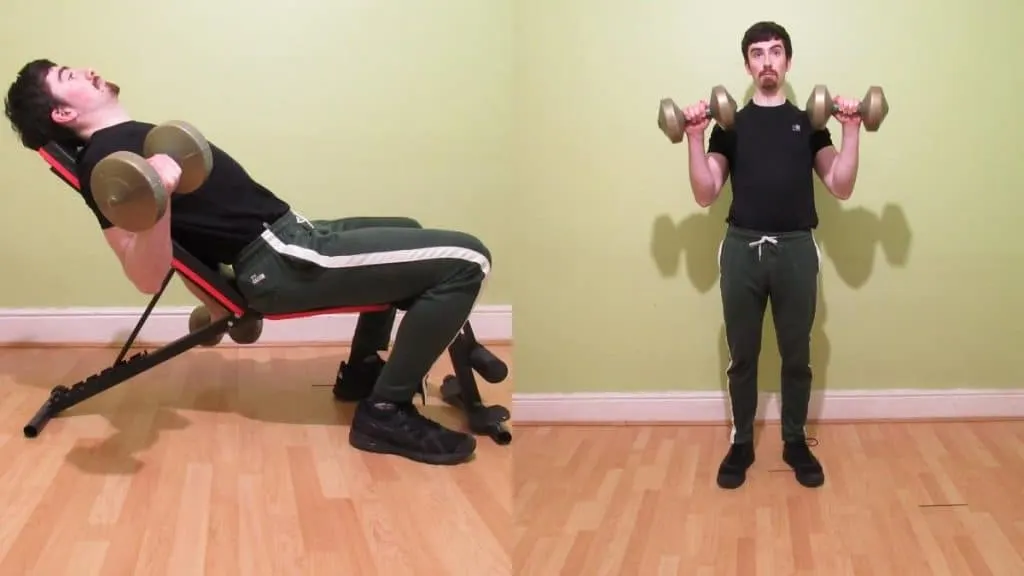
1: Incline curls — 3-5 sets of 8-10 reps
2: Dumbbell preacher curls — 3-5 sets of 10-15 reps
3: Reverse dumbbell curls — 3-5 sets of 10-15 reps
4: Zottman curls — 2 sets of 20 reps
This is one of the best bicep workouts with dumbbells that you can do as an intermediate lifter because it contains a variety of exercises and attacks the arms with different rep ranges.
The session begins with incline curls to focus on the often-underdeveloped long head of the biceps. Due to the intense muscle stretch that incline curls produce, they’re also a great exercise for building overall mass. The only downside, depending on where you’re training, is that you’ll also need access to a bench as well as weights.
Preacher curls focus on the short head of the biceps while also helping to minimize the development of muscular imbalances by having you train one arm at a time. If you don’t have a preacher pad, then you can do concentration curls instead and get virtually the same results.
Reverse dumbbell curls ensure that you build plenty of brachialis and brachioradialis size and don’t develop overly dominant biceps. After all, muscular biceps are only impressive when you have them in conjunction with a good overall upper body and, in particular, good arm development.
Zottman curls are the last of our DB bicep exercises and they’ll help to build overall arm size and fatigue the remaining muscle fibers. Since they’re the final movement in the routine, you can optionally train to failure on Zottman curls. But try to leave 1-2 reps in the tank on your other sets so that you can perform more overall training volume.
Rest 2-3 minutes between sets.
Workout 3: Advanced
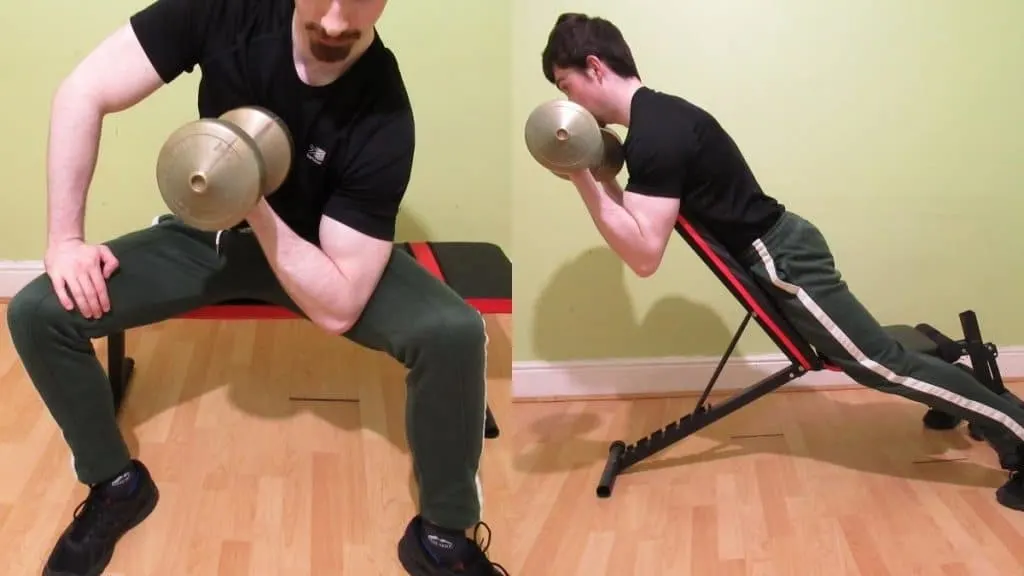
1: Hammer curls — 3-5 sets of 6-8 reps
2: Incline curls — 3-5 sets of 8-12 reps
3: Concentration curls — 3-5 sets of 10-15 reps
4: Spider curls — 3-5 sets of 12-15 reps
5: Reverse curls — 3-5 sets of 15-20 reps
This is the best bicep dumbbell workout to do if you’re an advanced lifter because it contains the highest amount of training volume and provides the most amount of exercise variety. So by hitting your biceps, brachialis, and brachioradialis from every conceivable angle with these dumbbell bicep exercises, you won’t be leaving an ounce of muscle growth on the table.
The exercise selection is similar to the other biceps dumbbell workouts that you saw above. The difference is that you’re doing both hammer curls and reverse curls rather than one or the other. So it’s a great routine for building a better brachialis (and thus a better bicep peak) and a muscular brachioradialis.
You’ll also be doing both concentration curls and spider curls so that you can isolate your biceps as much as possible and help them to reach their full genetic potential.
In addition to all the good dumbbell bicep exercises mentioned above, you’re also using multiple rep ranges (6-20 reps) to stimulate the broadest possible variety of muscle fibers. This ensures that you get to enjoy maximum bicep hypertrophy if you put the same effort into your diet and recovery.
How to get big biceps with dumbbells
Now you’re going to learn how to get bigger biceps with dumbbells by tweaking your form and some common training variables. These are the details that most lifters overlook but which can actually have a significant impact on your results.
Alternatively, you can also learn how to do bicep workouts without dumbbells if you don’t have access to any equipment.
Supinate your wrists forcefully
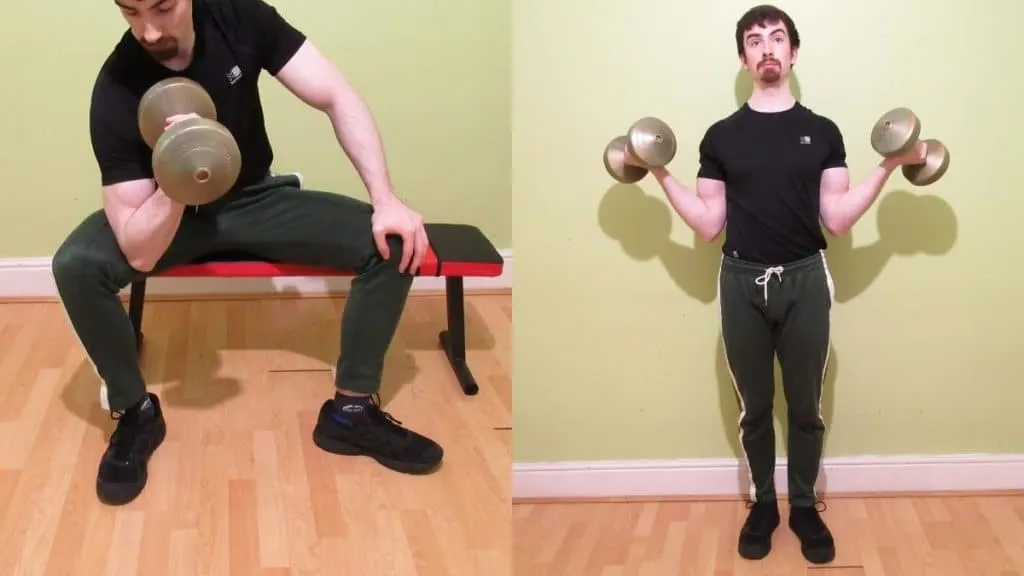
Since the biceps supinate the forearm as well as flex the elbow, you need to curl with your palms facing up if you want to get the best results possible. Yet, most people never achieve maximum wrist and forearm supination because they’re too focused on simply lifting the weight from A to B.
So if you want to get the absolute best dumbbell bicep workout, make sure to twist your little finger as much as possible at the top of every rep. In other words, you actually want to turn your pinky fingers away from your body so that you can intensify the peak contraction.
Just make sure to do this while you keep your elbows and shoulders still. The weights should rotate as a consequence of you twisting your wrists/hands rather than you simply moving your shoulders to simulate the twisting motion.
Increase your training frequency
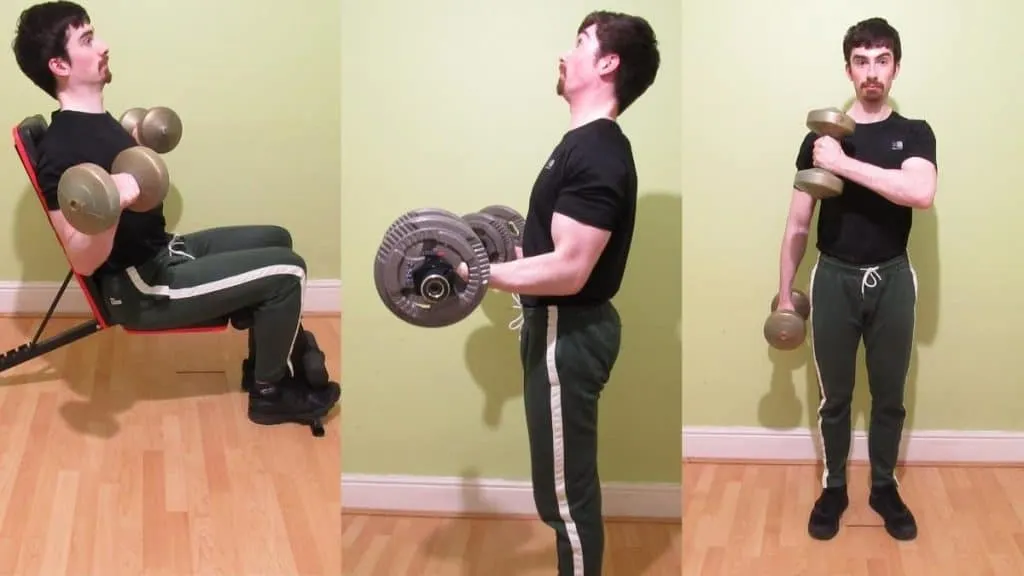
If you’re doing dumbbell workouts for biceps mass gain, then a training frequency of once per week might not be optimal for adding size. Since the biceps are a small muscle group, they need less total training volume than other body parts to grow. This naturally means that they can recover faster than other muscle groups because they’re simply being exposed to less stress and time under tension. That is, of course, unless you do too many sets!
As such, you can achieve excellent results by training your biceps 2-3 times per week (unless you’re an absolute beginner). The catch is that you’ll need to reduce your per session training volume to make a twice or thrice weekly setup feasible. So rather than doing 15 sets in one weekly session, you’ll simply split these sets into three sessions of 5 sets.
Training with the same number of sets but with a higher frequency actually allows you to perform more total training volume because you’ll be fresher on the subsequent sets and thus able to lift more weight. In other words, what used to be your 6th set in the old bicep dumbbell routine will essentially become your 1st set in the new workout because you’ll be performing the second block of 5 sets on a different day—therefore, you’ll be fresher, stronger, and able to accumulate more volume in the same timeframe. [3]
Working your biceps more frequently also allows you to take advantage of more regular protein synthesis spikes. This is important because protein synthesis spikes lead to hypertrophy. However, muscle protein synthesis also returns to baseline levels a few days after your workout. So to maximize your results, you want to train your biceps frequently so that they can always be in a growing state.
Train your biceps first
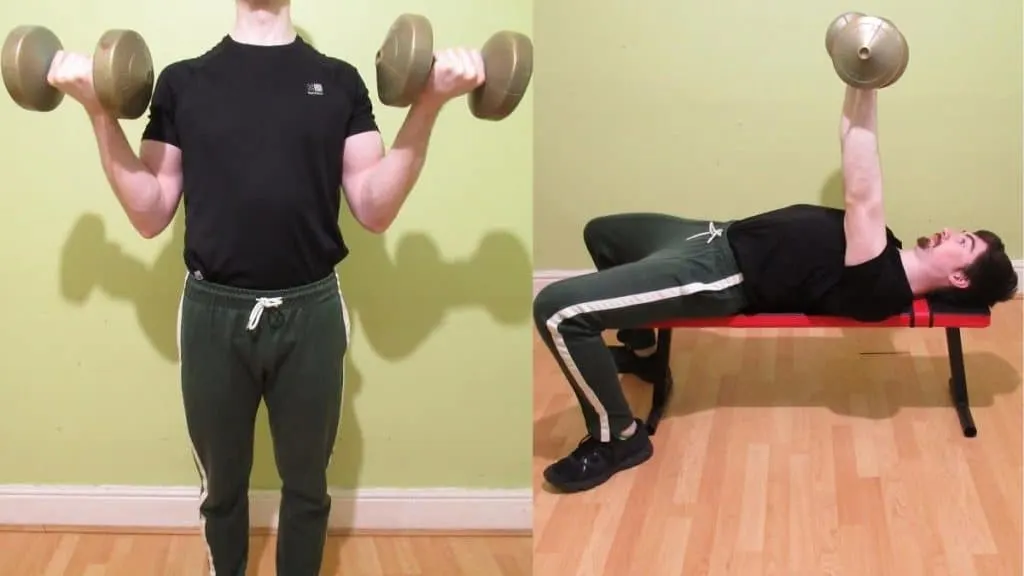
Many lifters do curls at the end of their workout and then wonder why their biceps are lagging.
Don’t let this be you.
There’s nothing wrong with starting a workout with bicep curls if your bis are truly underdeveloped in comparison with your other muscle groups.
Just be smart about it.
Don’t do curls at the beginning of a back and bicep workout with dumbbells because then you’ll weaken yourself on rows and pulldowns.
Instead, do some curls at the start of a push or leg workout. This way, you can sneak in extra bicep work without hindering your strength for the rest of the workout.
Related: Dumbbell forearm exercises
Conclusion: How to get good bicep workouts with dumbbells
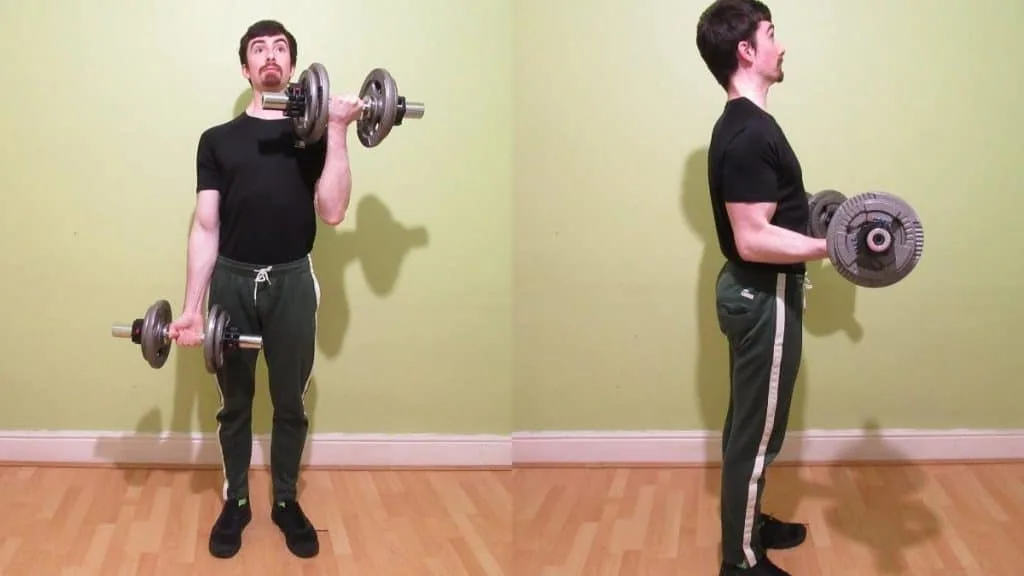
Now that you know all of the best dumbbell bicep exercises for mass gain, it’s time to select a workout to follow so that you can start building your bis. If you’ve been lifting for a while and/or want to fine-tune your routine based on your individual strengths and weaknesses, then you could use our exercise list for inspiration and craft your own custom routine.
On the other hand, if you just want to get on with blasting your biceps, then you can select from one of our trainer-designed dumbbell bicep workouts in order to take the guesswork out of creating a good routine.
As always, focus on nailing the proper form before lifting heavier dumbbells. Since the biceps are a small muscle group, you can achieve excellent results by using pretty light weights.
References
- Progression Models in Resistance Training for Healthy Adults. (2009a). Medicine & Science in Sports & Exercise, 41(3), 687–708. https://doi.org/10.1249/mss.0b013e3181915670
- Schoenfeld, B. J., Pope, Z. K., Benik, F. M., Hester, G. M., Sellers, J., Nooner, J. L., Schnaiter, J. A., Bond-Williams, K. E., Carter, A. S., Ross, C. L., Just, B. L., Henselmans, M., & Krieger, J. W. (2016). Longer Interset Rest Periods Enhance Muscle Strength and Hypertrophy in Resistance-Trained Men. Journal of Strength and Conditioning Research, 30(7), 1805–1812. https://doi.org/10.1519/jsc.0000000000001272
- Ochi, E., Maruo, M., Tsuchiya, Y., Ishii, N., Miura, K., & Sasaki, K. (2018). Higher Training Frequency Is Important for Gaining Muscular Strength Under Volume-Matched Training. Frontiers in Physiology, 9. https://doi.org/10.3389/fphys.2018.00744

